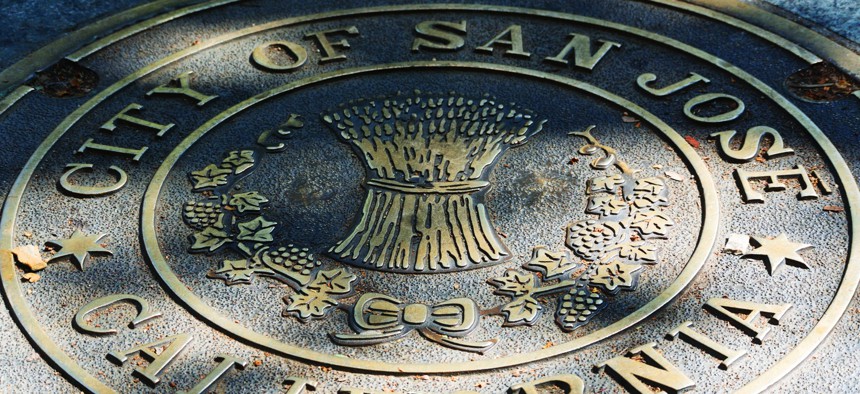San José’s Innovation Agenda Will Hinge on the Internet of Things

The city seal of San Jose, California Ruslan Kokarev / Shutterstock.com
Starfish, a new smart city network, will be demonstrated in the heart of Silicon Valley.
San José’s mayor plans to launch an ambitious innovation agenda this year, and a key component will be the transformation of the city’s streetscape through the Internet of Things.
In 2008, Silicon Valley’s unofficial capital became the first city to adopt a Demonstration Partnership Policy encouraging collaboration with the private sector and research and development institutions like universities.
The San José Demonstration Center opened in 2014 as a lab for local and large multinational companies. Prototypes developed there can be more broadly tested anywhere they benefit residents or local businesses. But it's at the demonstration center where cleantech and other innovations are beta tested while the local government evaluates them—the first case of a U.S. city using public land in that way.
“So the bottom line is the policy enables us to be the guinea pig for the latest innovations in our streetscape, in our transportation infrastructure, in our buildings—anywhere there is opportunity for widespread public benefit,” San José Mayor Sam Liccardo told Route Fifty in an interview. “We have grand ambitions around smart infrastructure and believe [an IoT] network can play a significant role.”
Enter Silver Spring Networks, a network service provider whose headquarters is moving to San José and whose new wireless IPv6 IoT network, Starfish, will be demonstrated in the city, California's third largest. Starfish boasts 1.2 Mbps speeds, a 50-mile point-to-point range and nearly limitless mesh range, industrial security and scalability, and Silver Spring Networks has seen 23 million IoT device connections.
San José is considering placing transportation sensors on Starfish for a fee to build infrastructure around collecting data on everything from traffic congestion to vehicle emissions.
“In the next year to 18 months, I think we’ll see more and more cities lighting up networks and not just saying, ‘Let’s see how this works,’ but with a very specific, measurable business case behind it,” said Eric Dresselhuys, SSN's executive vice president.
The company got its start much the same way as Amazon Web Services, building giant data centers worldwide before realizing government agency clients might want their applications on the resulting network. And unlike 4G and future 5G cellular networks, Starfish is designed for fixed wireless devices and point-to-point applications.
Cost prohibitive cell networks frequently fail to provide the coverage needed for infrastructure projects, Dresselhuys said, because if the signal can’t penetrate the wall, say, a sensor-connected water meter is behind, that device can’t be easily moved.
On Starfish, every device in a system serves as a repeater for relaying messages. The more devices in a mesh network, the stronger, more reliable the system.
Put another way, the slowness cell users experience when their plane lands and everyone turns on their phones at once, causing a traffic surge to the nearest cell tower, doesn’t happen on Starfish.
The cost savings are another reason San José is eyeing Starfish—municipal budgets are strained almost everywhere. Costs of adding incremental devices are marginal, Dresselhuys said, and the system improves every time.
“The most immediate focus might be around safety,” Liccardo said. “We know with data we’ve collected there’s a high percentage of injury crashes on a small percentage of roads, and where we’re able to use sensor tech to assess vehicle speeds and driver behavior, that can dramatically help focus our scarce resources.”
Analytics are also possible between systems, so when traffic peaks and more CO and NO2 emissions are detected by environmental sensors, networked lights can be adjusted to affect flow.
Water conservation is another concern in San Jose, leaving the city to consider smart metering where customers are empowered with use info sent to their smartphones.
“We want to create a network that identifies spikes in usage, which can help users learn if they have a leak or if a child’s leaving a hose on in the backyard,” Liccardo said. “There are many ways technology can help us dramatically improve conservation of a very scarce resource.”
Dave Nyczepir is a News Editor at Government Executive’s Route Fifty. (Photo by Ruslan Kokarev / Shutterstock.com)
NEXT STORY: Why Many Cities Should Be Envious of D.C.'s Parks and Recreation Programs






